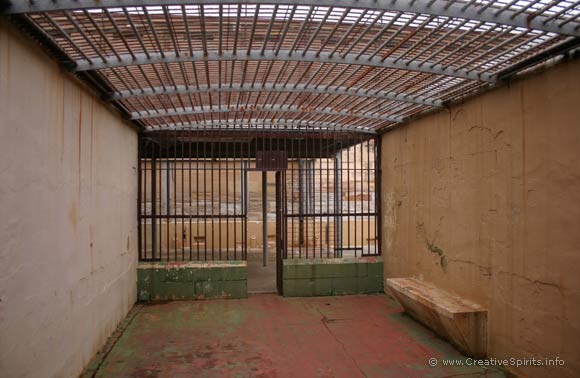Law & justice
Improving Aboriginal prison conditions
Prisons need to cater for specific cultural needs of their Aboriginal inmates and avoid 'structural racism'. Aboriginal-sensitive standards can help.

Wishing you knew more about Aboriginal culture? Search no more.
Get key foundational knowledge about Aboriginal culture in a fun and engaging way.
This is no ordinary resource: It includes a fictional story, quizzes, crosswords and even a treasure hunt.
Stop feeling bad about not knowing. Make it fun to know better.

Prisons are not designed for Aboriginal people
The prison experience for Aboriginal people is different than for non-Aboriginal people. Usually, prison standards and regimes are developed for Western society and applied to all prisoners regardless of their descent.
But prison rates in Australia show that many prisons now host a majority of Aboriginal inmates. It makes sense to change protocols to cater for this majority and avoid what is called 'structural racism'.
Story: Heat, snakes and mice: The worst prison in Western Australia
An inspection in 2016 described a medium-security prison in Western Australia with about 80% Aboriginal inmates as the worst prison in WA and a danger to inmates. And not much has changed three years later. Torn fly screens allow snakes and mice to infest cells.
The Roebourne prison has no air-conditioning for any area of the inmates, while staff enjoy this comfort even for their toilets. Temperatures have previously reached 48 degrees in summer. Corrective Services in WA claim that local prisoners are used to the heat, a view which ignores the fact that prisoners are routinely locked in a small room with one or more other person for 12 hours or more each night. [1]
How to create better prisons
Retired Custodial Inspector Professor Richard Harding has inspected more than 55 prisons over eight years. [2] He labels some of them 'Aboriginal prisons' to draw attention to the conditions and lack of resources, which he says "would not have been tolerated if the population had been predominantly non-Aboriginal," which he defines as 'structural racism'.
Aboriginal prisons in this sense are, for example in Western Australia, Broome, Roebourne, Eastern Goldfields and Greenough. [2]
Aboriginal-sensitive standards, championed by the Office of the Custodial Inspector, include the following:
- Custody should be 'in-country' rather than 'out-of-country'. Too many Aboriginal prisoners are incarcerated hundreds of kilometres from their home country.
- Minimise long-distance transports. One such transport on 25 January 2008 led to the painful death of an Aboriginal prisoner in extreme 42-degrees heat.
- Recognise funeral obligations of Aboriginal people and implement processes to meet those obligations.
- Recognise elders and their role in prisons, especially in relation to younger prisoners.
- Train prison staff to be culturally respectful and stop using racist slurs and abuse.
- Increase Aboriginal staff working in prisons.
- Mandatory health checks when Aboriginal prisoners are admitted.
- Prepare for release through offender treatment and training programs.
- Release back to country rather than leaving them stranded out-of-country.
Aboriginal prisons are less funded than others. [2] Roebourne, for example, has a history of high temperatures, over-crowding and inadequate visiting areas (see story above).
A converted prison unit in Perth caters specifically for Aboriginal prisoners. It opened in December 2007 and was designed to reduce prisoner self-harm. [3] The design incorporated the following features.
- Buddy system where a prisoner who does not need to be in a 'safe cell' or crisis care unit can opt to share a cell with a friend or relative.
- An Aboriginal support officer is appointed to the prison.
- Traditional cooking pits and prisoners' artworks offer a sense of community, especially for those isolated by distance.
- Cultural workshops are run where prisoners can undertake carving, music, dance, art and painting, but also cognitive intervention, men's health, rural horticulture and other vocational skills that are reflective of the needs for remote community living.
- Staff training to help them recognise symptoms of mental health, and reduce rates of self-harm.
A correctional centre in Victoria has set up an Aboriginal site within the prison called 'Madong Kurradba (Strong Ground). [4]
The site features an Aboriginal scarred tree, a dancing pit, fire pit, totem pole, humpies and a range of stencilled native animals made from wood and steel. It is aimed at helping Aboriginal men maintain their culture and contact with the land while in custody.
The site was designed and built by the Koorie inmates.
Story: The Torch programme
The Torch is a successful arts programme that in 2017 operated in 12 of Victorian prisons. It supports inmates to learn, share and express culture, often through painting.
The programme helped change Victorian prison policy to allow prisoners to sell their artwork while inside. Such self-generated income not only lifts self-esteem and confidence, it also allows prisoners to leave prison with sometimes a few thousand dollars, giving them a good start into economic independence.
After their release, the men and women used this to start careers as artists, support their families, enrol in university or licensed their artworks to governments and organisations.
The Torch programme also helped reduce participants reduce their reoffending rate by 53%. [5]